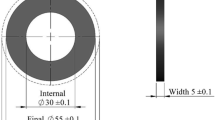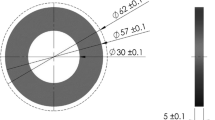Abstract
The hardening of legislation in favor of socio-environmental preservation and the sustainable focus of industry are changing the current manufacturing methods, among which is grinding. This abrasion machining technique aims to produce parts with excellent surface finish and high geometric precision. On the other hand, the multiple sharp edges of the abrasive grains that make up the grinding wheel simultaneously deform and shear the workpiece surface material, which releases a lot of energy in the form of heat. In this context, to soften the damage caused by the high temperatures, cutting fluids are applied to lubricate and refrigerate the tool/workpiece interface during the grinding process. However, the use of these fluids is damaging to people’s health and carries a high cost for disposal, given their potential to impact the biosphere. In this sense, the society allied with the researchers seeks alternative methods of lubri-refrigeration, among them, the minimum quantity lubrication (MQL), which applies a small quantity of fluid to the cutting zone through a flow of compressed air. However, the excessive increase of machining temperatures and the intensification of the grinding wheel clogging are significant drawbacks of this technique. Thus, to mitigate these problems, this work seeks to evaluate the traditional MQL application, MQL with cooled air (MQL+CA), and assisted by a wheel cleaning jet (MQL+WCJ), comparing them with the conventional method with abundant fluid, in the external cylindrical plunge grinding of the AISI 4340 steel using an aluminum oxide grinding wheel. The output parameters used to assess the efficiency of the techniques were surface roughness, roundness error, diametrical wheel wear, grinding power, tangential cutting force, specific grinding energy, and microhardness. The machined surfaces were evaluated through optical and scanning electron microscopies to verify possible thermal damages and microstructural alterations, and optical microscopy images of the grinding wheel cutting surface were assessed to ascertain the occurrence of the wheel clogging phenomenon. The results of the tests showed that the conventional method produced the best results in all analyzed parameters. Besides, MQL+WCJ and MQL+CA outperformed all the results obtained with traditional MQL, which revealed the improvement obtained with these eco-friendly techniques and their applicability in the industry. Moreover, the application of the MQL+WCJ provided the closest results in comparison with the conventional method, proving to be superior to the MQL+CA.















Similar content being viewed by others
References
Pušavec F, Stoić A, Kopač J (2010) Sustainable machining process-myth or reality. Strojarstvo 52:197–204
Marinescu ID, Hitchiner M, Uhlmann E, Rowe WB (2007) Handbook of machining with grinding wheels, 1st edn. CRC Press, New York
Silva LR, Corrêa ECS, Brandão JR, de Ávila RF (2013) Environmentally friendly manufacturing: behavior analysis of minimum quantity of lubricant - MQL in grinding process. J Clean Prod. https://doi.org/10.1016/j.jclepro.2013.01.033
Talon AG, Lopes JC, Tavares AB, et al (2019) Effect of hardened steel grinding using aluminum oxide wheel under application of cutting fluid with corrosion inhibitors. Int J Adv Manuf Technol 104:1437–1448. https://doi.org/10.1007/s00170-019-04005-5
Bianchi EC, Rodriguez RL, Hildebrandt RA, Lopes JC, Mello HJ, Silva RB, Aguiar PR (2018) Plunge cylindrical grinding with the minimum quantity lubrication coolant technique assisted with wheel cleaning system. Int J Adv Manuf Technol 95:2907–2916. https://doi.org/10.1007/s00170-017-1396-5
de Mello HJ, de Mello DR, Rodriguez RL et al (2018) Contribution to cylindrical grinding of interrupted surfaces of hardened steel with medium grit wheel. Int J Adv Manuf Technol 95:4049–4057. https://doi.org/10.1007/s00170-017-1552-y
Holesovsky F, Hrala M (2004) Integrity of ground cylindrical surface. J Mater Process Technol 153–154:714–721. https://doi.org/10.1016/j.jmatprotec.2004.04.180
Ebbrell S, Woolley NH, Tridimas YD et al (2000) Effects of cutting fluid application methods on the grinding process. Int J Mach Tools Manuf 40:209–223. https://doi.org/10.1016/S0890-6955(99)00060-7
Tawakoli T, Westkämper E, Rabiey M, Rasifard A (2007) Influence of the type of coolant lubricant in grinding with CBN tools. Int J Mach Tools Manuf 47:734–739. https://doi.org/10.1016/j.ijmachtools.2006.09.010
Shokoohi Y, Khosrojerdi E, Rassolian Shiadhi BH (2015) Machining and ecological effects of a new developed cutting fluid in combination with different cooling techniques on turning operation. J Clean Prod 94:330–339
Matthew S (2009) Metal working fluids: finding green in the manufacturing process. Ind Lubr Tribol 61:60–66. https://doi.org/10.1108/00368790910940374
Zhang J, Li C, Zhang Y et al (2018) Experimental assessment of an environmentally friendly grinding process using nanofluid minimum quantity lubrication with cryogenic air. J Clean Prod 193:236–248. https://doi.org/10.1016/j.jclepro.2018.05.009
Bianchi EC, Destro RS, Oikawa MH et al (2010) The minimum quantity of lubricant (MQL) technique in the surface grinding of steel. WIT Trans Eng Sci 66:249–260. https://doi.org/10.2495/TD100211
Lopes JC, Ventura CEH, Rodriguez RL, Talon AG, Volpato RS, Sato BK, Mello HJ, Aguiar PR, Bianchi EC (2018) Application of minimum quantity lubrication with addition of water in the grinding of alumina. Int J Adv Manuf Technol 97:1951–1959. https://doi.org/10.1007/s00170-018-2085-8
Tawakoli T, Hadad M, Sadeghi MH et al (2011) Minimum quantity lubrication in grinding: effects of abrasive and coolant-lubricant types. J Clean Prod 19:2088–2099. https://doi.org/10.1016/j.jclepro.2011.06.020
Godino L, Pombo I, Sanchez JA, Alvarez J (2018) On the development and evolution of wear flats in microcrystalline sintered alumina grinding wheels. J Manuf Process 32:494–505. https://doi.org/10.1016/j.jmapro.2018.03.023
Rodriguez RL, Lopes JC, Mancini SD, Ângelo Sanchez LE, Almeida Varasquim FMF, Volpato RS, Mello HJ, Aguiar PR, Bianchi EC (2019) Contribution for minimization the usage of cutting fluids in CFRP grinding. Int J Adv Manuf Technol 103:487–497. https://doi.org/10.1007/s00170-019-03529-0
Javaroni RL, Lopes JC, Sato BK, Sanchez LEA, Mello HJ, Aguiar PR, Bianchi EC (2019) Minimum quantity of lubrication (MQL) as an eco-friendly alternative to the cutting fluids in advanced ceramics grinding. Int J Adv Manuf Technol 103:2809–2819. https://doi.org/10.1007/s00170-019-03697-z
Cameron A, Bauer R, Warkentin A (2010) An investigation of the effects of wheel-cleaning parameters in creep-feed grinding. Int J Mach Tools Manuf 50:126–130. https://doi.org/10.1016/j.ijmachtools.2009.08.008
Lopes JC, Ventura CEH, de M. Fernandes L et al (2019) Application of a wheel cleaning system during grinding of alumina with minimum quantity lubrication. Int J Adv Manuf Technol 102:333–341. https://doi.org/10.1007/s00170-018-3174-4
Malkin S, Guo C (2008) Grinding technology: theory and applications of machining with abrasives, 2nd edn. Industrial Press Inc, New York
de Oliveira D J, Guermandi LG, Bianchi EC et al (2012) Improving minimum quantity lubrication in CBN grinding using compressed air wheel cleaning. J Mater Process Technol 212:2559–2568. https://doi.org/10.1016/j.jmatprotec.2012.05.019
Bianchi EC, Sato BK, Sales AR, Lopes JC, Mello HJ, Angelo Sanchez LE, Diniz AE, Aguiar PR (2018) Evaluating the effect of the compressed air wheel cleaning in grinding the AISI 4340 steel with CBN and MQL with water. Int J Adv Manuf Technol 95:2855–2864. https://doi.org/10.1007/s00170-017-1433-4
Beretta S, Romano S (2017) A comparison of fatigue strength sensitivity to defects for materials manufactured by AM or traditional processes. Int J Fatigue 94:178–191. https://doi.org/10.1016/j.ijfatigue.2016.06.020
Malkin S, Guo C (2007) Thermal analysis of grinding. CIRP Ann Manuf Technol 56:760–782. https://doi.org/10.1016/j.cirp.2007.10.005
Lopes JC, de Martini FL, Domingues BB et al (2019) Effect of CBN grain friability in hardened steel plunge grinding. Int J Adv Manuf Technol 103:1567–1577. https://doi.org/10.1007/s00170-019-03654-w
Hadad MJ, Tawakoli T, Sadeghi MH, Sadeghi B (2012) Temperature and energy partition in minimum quantity lubrication-MQL grinding process. Int J Mach Tools Manuf 54–55:10–17. https://doi.org/10.1016/j.ijmachtools.2011.11.010
Ashrafijou M, Saberi A, Rabiei F et al (2016) Improvement of surface grinding process performance of CK45 soft steel by minimum quantity lubrication (MQL) technique using compressed cold air jet from vortex tube. J Clean Prod 131:728–738
Choi HZ, Lee SW, Do Jeong H (2002) The cooling effects of compressed cold air in cylindrical grinding with alumina and CBN wheels. In: Journal of Materials Processing Technology. pp 155–158
Xiao KQ, Zhang LC (2006) The effect of compressed cold air and vegetable oil on the subsurface residual stress of ground tool steel. J Mater Process Technol 178:9–13. https://doi.org/10.1016/j.jmatprotec.2005.05.013
Tawakoli T, Hadad MJ, Sadeghi MH et al (2009) An experimental investigation of the effects of workpiece and grinding parameters on minimum quantity lubrication-MQL grinding. Int J Mach Tools Manuf 49:924–932. https://doi.org/10.1016/j.ijmachtools.2009.06.015
Bianchi EC, Aguiar PR, Canarim RC, Diniz AE (2013) Optimization of minimum quantity lubrication in grinding with CBN wheels. In: Machining and machine-tools: Elsevier, pp 113–133
Bianchi EC, Rodriguez RL, Hildebrandt RA et al (2019) Application of the auxiliary wheel cleaning jet in the plunge cylindrical grinding with minimum quantity lubrication technique under various flow rates. Proc Inst Mech Eng Part B J Eng Manuf 233:1144–1156. https://doi.org/10.1177/0954405418774599
de Martini FL, Lopes JC, Volpato RS et al (2018) Comparative analysis of two CBN grinding wheels performance in nodular cast iron plunge grinding. Int J Adv Manuf Technol 98:237–249. https://doi.org/10.1007/s00170-018-2133-4
de Belentani R M, Funes Júnior H, Canarim RC et al (2013) Utilization of minimum quantity lubrication (MQL) with water in CBN grinding of steel. Mater Res 17:88–96. https://doi.org/10.1590/s1516-14392013005000165
Rowe WB (2014) Principles of modern grinding technology. Elsevier, Amsterdam
Silva LR, Bianchi EC, Catai RE et al (2005) Study on the behavior of the minimum quantity lubricant - MQL technique under different lubricating and cooling conditions when grinding ABNT 4340 steel. J Braz Soc Mech Sci Eng 27:192–199. https://doi.org/10.1590/S1678-58782005000200012
Rodriguez RL, Lopes JC, Hildebrandt RA et al (2019) Evaluation of grinding process using simultaneously MQL technique and cleaning jet on grinding wheel surface. J Mater Process Technol 271:357–367. https://doi.org/10.1016/j.jmatprotec.2019.03.019
Barbacki A, Kawalec M, Hamrol A (2003) Turning and grinding as a source of microstructural changes in the surface layer of hardened steel. J Mater Process Technol 133:21–25. https://doi.org/10.1016/S0924-0136(02)00211-X
Choi TJ, Subrahmanya N, Li H, Shin YC (2008) Generalized practical models of cylindrical plunge grinding processes. Int J Mach Tools Manuf 48:61–72. https://doi.org/10.1016/j.ijmachtools.2007.07.010
Mao C, Zhou Z, Zhang J et al (2011) An experimental investigation of affected layers formed in grinding of AISI 52100 steel. Int J Adv Manuf Technol 54:515–523. https://doi.org/10.1007/s00170-010-2965-z
Acknowledgments
The authors would like to thank companies Norton Abrasives - Saint Gobain Group for providing the grinding wheel, ITW Chemical Products for the donation of the cutting fluids, and Emuge-Franken for the donation of the vortex tube and the authors thank everyone by supporting the research and opportunity for scientific and technological development.
Funding
The authors thank the São Paulo Research Foundation (FAPESP) (process 2018/22661-2), CAPES (Coordination for the Improvement of Higher Level Education Personnel), and CNPq (National Council for Scientific and Technological Development) for their financial support of this research.
Author information
Authors and Affiliations
Corresponding author
Ethics declarations
Conflict of interest
The authors declare that they have no conflict of interest.
Additional information
Publisher’s note
Springer Nature remains neutral with regard to jurisdictional claims in published maps and institutional affiliations.
Rights and permissions
About this article
Cite this article
Lopes, J.C., Garcia, M.V., Valentim, M. et al. Grinding performance using variants of the MQL technique: MQL with cooled air and MQL simultaneous to the wheel cleaning jet. Int J Adv Manuf Technol 105, 4429–4442 (2019). https://doi.org/10.1007/s00170-019-04574-5
Received:
Accepted:
Published:
Issue Date:
DOI: https://doi.org/10.1007/s00170-019-04574-5




